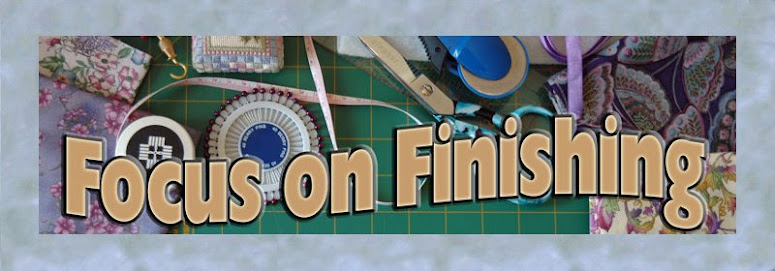Welcome to the beaded scissor fob tutorial! I am posting this a bit early, because I know that there are many readers who are in much earlier time zones, and I want to make sure that these instructions are available for the weekend. These fobs are so pretty...and so quick and fun to make. I hope that you find this to be an enjoyable project.
I am right-handed, so I am writing the instructions from that perspective.
Cut a length of
beading thread. You will be doubling up the thread, and will want it long enough to be able to run it through the length of your fob several times, especially if you are using heavy beads. Now is not the time to be stingy with thread :)
Fold your beading thread in half, and thread the two loose ends through the needle. You will have a loop at the other end.
Pick up the lobster claw clasp and pass the threaded needle through the loop in the clasp. Now pass the needle through the looped end of the beading thread, and pull tight. This knot is called a lark's head knot, and a good picture of it can be found
here.
Now, you need to make a couple more knots to make sure your beading thread is secure. Don't worry...it's not hard. Relax and take a couple of deep breaths :)
Refer to the series of pictures below for clarification of the procedure.
Hold the lobster claw clasp in your left hand. I hold it between my thumb and ring / pinky finger. Create a loop by loosely wrapping the thread around your index finger on your left hand. Pass the needle through the loop in the lobster claw clasp, and then through the loop in the thread. Pull tight. Repeat this a couple more times.
Knotting procedure pictures:
You will be repeating the steps above a bit later on. The good news is that this is as complicated as it gets!
Thread your selected beads and spacers onto the beading thread until you are happy with the length and appearance. There aren't any rules here! If you don't like what you have done, it is easy enough to change the arrangement. I usually like to keep the beaded portion of my fobs around 4 inches, especially if I am using large glass beads. If you are using more delicate beads, you could make it longer. I also like to use the spacers at the beginning and end of the fob, and between the beads as accents. When you are happy with your design, carefully set your fob aside while you do the next step.
Thread the jump ring onto the charm. This is always the hardest part for me...and especially so if you have long fingernails :)
Carefully pick your fob back up and thread on the charm.
If you are using lightweight beads, you could knot the charm on at this point, following the same knotting procedure shown in the pictures above. You also would probably not need to run the thread back and forth through the fob several times as I describe below. I have found that the knotting the charm on and maintaining the proper slack is very difficult to do at this point if you are using heavier glass beads like I have chosen. I also feel safer about the durability of the fob if I run the thread through the length of it several times. You can decide if it is necessary or not, depending upon the materials that you have selected. If you choose to skip all of this, feel free to jump on down to the ending off portion of the instructions :)

Run the needle and thread all of the way back through your beads until you get back to the lobster claw clasp. It works best to run your needle through a couple of beads at a time while you are doing this. Once you are back up to the lobster claw clasp, make sure that you have the desired amount of slack between all of the beads and charm. You don't want it to be too tight, since it won't be flexible. Too loose isn't good, either. I have found that it is easier to achieve the appropriate slack if you do this rather than trying to knot the charm on directly.
Make another knot or two on the lobster claw clasp end, using the same process that you used in the beginning (refer back to the series of knotting procedure pictures above).
Now you are going to run the beading thread back to the charm end, using the same process that you used to get to the lobster claw clasp end. When you reach the charm, make a couple of knots to secure the charm. Again, you will use the same process shown in the series of hand pictures above).
If you have chosen to jump ahead, here is where you will pick up the instructions again...
Run the beading thread partially back up the the length of the fob. Make a couple more knots to secure, and then run the thread back up a couple of beads or so before cutting it off.
If desired, you can reinforce your knots on the lobster claw clasp end and charm end with a dab of clear nail polish.
That's it! Stand back and admire your beautiful creation. I'm sure that you will now want to make several more of these :)
If you have any questions or need clarification on anything, please do not hesitate to leave a comment or send me an e-mail.
Tutor = Cindy













